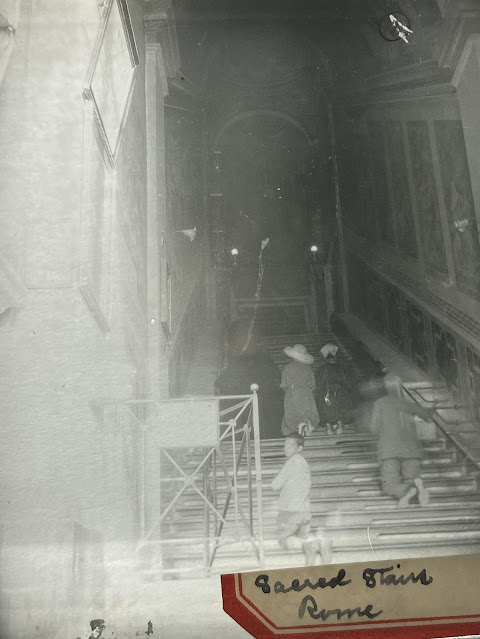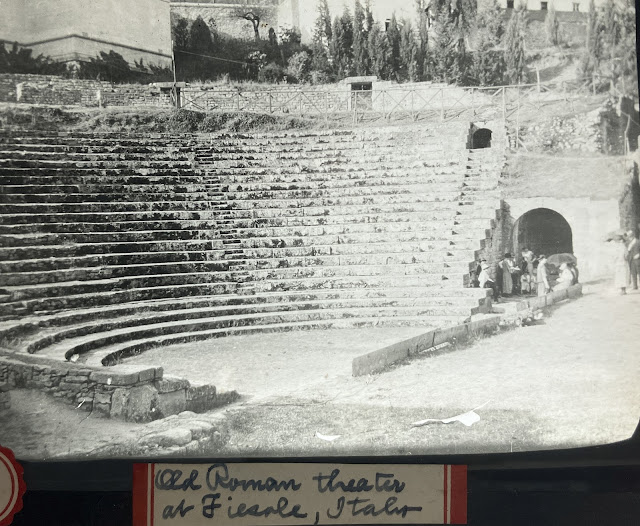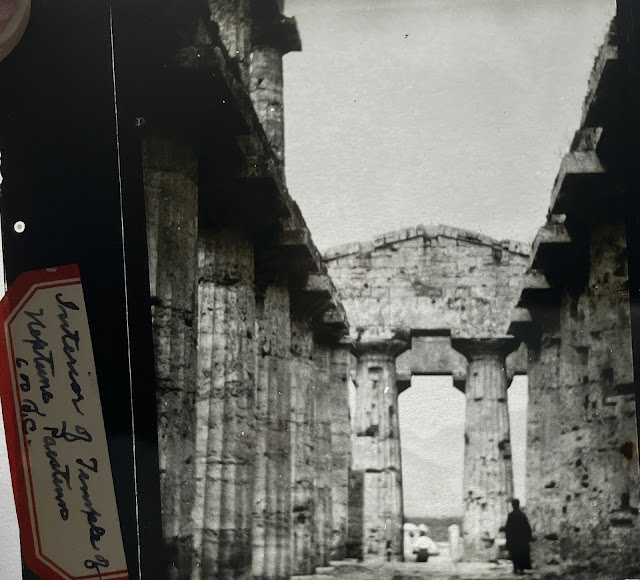In an earlier blog post I told the story of the glass lantern slides that Huron College Latin professor Louise French had made. These lantern slides are the blending of her loves of both travel and photography.

Friday, December 9, 2022
The Photography of Louise French - Album 4
Sunday, December 4, 2022
Bell Bakery and the I.O.O.F. Building
Every Christmas when I make date filled cookies, I think back to the first year I made them to take to my grandmother's house for the holidays. I had never heard of them and was planning on surprising her, assuming that she hadn't heard of them either. But it was me who was surprised when she said, “Oh! Filled cookies! My dad made those at his bakery, and they were so good that people would come from miles around to get them.” My disappointment about the spoiled surprised was quickly overshadowed by the realization that my great-grandpa Pete had been a baker and had baked the same cookies I just had. I knew little about him at that time, but that conversation with my grandmother would begin to change that.
Peter Christensen immigrated from Denmark in 1900 at the age of 17, destined for Council Bluffs, Iowa. He learned the baking trade in Omaha, Nebraska and worked in the trade for several years in Council Bluffs. He met Clarence Bell, a bakery owner of Missouri Valley, Iowa. The two men decided to go into business together and for reasons unknown focused on purchasing the City Bakery in Huron, South Dakota. Neither of the men had any known connection to Huron, but this particular bakery had changed hands several times in the two previous years so perhaps they felt this would be a good investment. They sealed the deal on City Bakery on September 23, 1908 and immediately began making improvements.
 |
| The original wood-frame Bell Bakery shop, just to the left of the Costain Building. This is the 300 block of Dakota Ave. South. |
Clarence Bell and his wife Tilda purchased a home in Huron, and Peter Christensen lived above the bakery until his marriage two years later. Bell and Christensen made improvements to the wood frame building, including a new oven and an expansion to the building, both in 1910. Bell handled the business affairs, while Christensen handled the baking operations.
 |
| A Bell Bakery advertisement from 1910 in a Huron newspaper |
In 1914, plans were made for a new I.O.O.F. building, three stories in height, to be built right where Bell Bakery stood. The new building was to be built of brown vitrified brick trimmed with cream colored Bedford limestone, 50 feet in width and 115 feet long. The existing bakery building, meanwhile, was moved nearby (behind the Marvin Hughitt Hotel), allowing the business to continue to operate during the construction process. But the move didn't go smoothly. “The Bell Bakery is now comfortably located on Fourth street just off the avenue, after a somewhat tempestuous journey across the street and around the corner. The building held together very well, until nearly in place, when a section of the south wall bulged badly. This will not, however, be a serious matter, as it was braced up at once,” wrote the local newspaper. Construction of the new building was to begin immediately.
 |
| The two-story wood frame Bell Bakery building at its "new" location on Fourth street, west of the Marvin Hughitt. The building would later be sold and moved again. |
By mid-October the I.O.O.F. Building was near completion. Bell Bakery would occupy the southernmost main floor store front (340 Dakota Ave.), and Mills Grocery the north store front. Offices and some Odd Fellow reading rooms would occupy the second floor. A large 50' square lodge hall was to be at the front of the 3rd floor with dining rooms and a kitchen among other things in the remainder of the space. Bell's new space was completed in early December 1914.
An addition was constructed to the bakery space, giving it a length of 165 feet. The front portion of the bakery was a “very handsome” sales room with display cases designed for keeping the baked goods from drying out. The shop was located to the rear and was outfitted with modern equipment and machinery.
 |
| Bell Bakery workers. Pete Christensen is 2nd from right; to his left is his brother, Soren Christensen, who was learning the baking trade from his brother. |
 |
| Inside the bakery; Pete Christensen at left. |
 |
| Pete's handwritten recipe for Cream Puffs, courtesy of Ree Lyons. |
In 1920, Pete sold his interest in the bakery to Erwin G. Schmidt and purchased a farm southwest of Huron. He farmed until 1946 when he retired, sold his farm and moved to Gardena, California. He passed away in 1960.
Erwin Schmidt eventually purchased Clarence Bell's interest in the bakery as well and conducted the business until 1950, when it was closed in an involuntary bankruptcy proceeding. The equipment was sold to a Mitchell restaurant, and the Singer Sewing Machine company then took over the vacant store space.
Friday, December 2, 2022
The Photography of Louise French - Album 3 - Italy
In an earlier blog post I told the story of the glass lantern slides that Huron College Latin professor Louise French had made. These lantern slides are the blending of her loves of both travel and photography.
Friday, November 25, 2022
The Photography of Louise French - Album 2 - Unmounted photos from Rome
In an earlier blog post I told the story of the glass lantern slides that Huron College Latin professor Louise French had made. These lantern slides are the blending of her loves of both travel and photography.
Friday, November 18, 2022
The Photography of Louise French - Album 1
In an earlier blog post I told the story of the glass lantern slides that Huron College Latin professor Louise French had made. These lantern slides are the blending of her loves of both travel and photography.
 |
Thursday, November 10, 2022
Historical Lantern Slides from Huron College
 |
| Voorhees Hall |
The heart of Huron College, Voorhees Hall, along with other college buildings had their contents auctioned off and were demolished. I loved that building; you could feel the 103 years of history as you walked through it. I always regretted that I was not there for the auction, just to get a small piece of it. I missed it. But my dad didn't.
Recently, he offered me a large collection of glass slides he had purchased at the auction – about 300 of them stored in plastic shoeboxes, with about 70 more in other small boxes. I happily took them, and quickly discovered they were “Lantern slides” - positive photographic images put onto a piece of glass and covered by a second piece of glass, bound on all sides with black paper tape. Inside the boxes with the slides were some other items – many pictures of classic art that had been cut out and mounted on pieces of cardboard, some small boxes and an old envelope that had been used as scratch paper. All in all, these were reminiscent of materials that might have been used by a teacher. There were a couple of clues as to who these items belonged to and how old they might be – the back of one of the cardboard mountings had some writing referring to an insurance check from 1932, and the envelope had “Louise French, 510 Nebraska SW” written on it. A quick check of the 1930 census showed Louise French as a roomer at this address, along with her occupation of teacher at the college. Bingo!Another item I received from my dad was a small cabinet with drawers like a card catalog. As I was cleaning it up, I noticed most of the drawers were labeled:
I suspect these slides were owned and donated by Miss French to Huron College after her retirement. Some of the glass slides apparently had been ordered from commercial companies (see catalogs at left). I suspect that Miss French also made some of these lantern slides herself. Two of the small cardboard boxes among the slides are labeled, “Thin Cover Glass for Lantern Slides” and "Eastman Lantern Slide Plates," both ordered from Eastman Kodak company. For whatever reason, some of her lantern slides were never mounted, and the boxes are labeled as such.
In 1909 she was one of the winners of a contest put on by the Sioux Falls Argus Leader; the prize was a trip to Colorado, which would be her second trip to the state. She would make a third trip to the area in 1929. There she took numerous photos that ended up as lantern slides.
She took a 3 month trip overseas visiting Holland, Austria, Germany, Belgium Switzerland, Italy, France, the British Isles, and Greece. She departed at the port of New York aboard the S.S. La France on June 29, 1922. Lantern slides labeled Italy, 1922 are among her collection. She was able to make two overseas trips in her years at Huron College.
























































